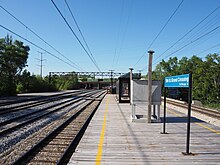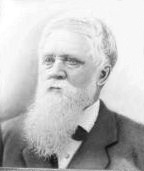| The Greater Grand Crossing Rail Collision | |
|---|---|
 Site of the accident, 1902 Site of the accident, 1902 | |
| Details | |
| Date | April 26, 1853; 171 years ago (1853-04-26) 10:00 p.m. |
| Location | Greater Grand Crossing, Chicago |
| Coordinates | 41°45′31″N 87°35′45″W / 41.758694°N 87.59575°W / 41.758694; -87.59575 |
| Incident type | Collision |
| Cause | Poor visibility, lack of signal |
| Statistics | |
| Trains | 2 |
| Deaths | 18-21 |
| Injured | 40-60 |
| List of rail accidents (before 1880) | |
The Greater Grand Crossing Rail Collision was a train collision that occurred in Greater Grand Crossing, Chicago in 1853.
Background
In 1853, Lake Shore and Michigan Southern Railway and the Illinois Central Railroad were both involved in a fight over right-of-way and possession of railway lines that is also known as a frog war. The two opposing lines intersected in Hyde Park, Chicago, resulting in the creation of Grand Crossing. Roswell B. Mason, the first Chief Engineer of the Illinois Central Railroad, was responsible for the main construction of the crossing, although the construction itself was not done legally. At the time of the collision, there were no traffic signals for the locomotive engineers.
The site of the accident is now the intersection of 75th Street and South Chicago Avenue. At the time that the incident occurred, the site was still underdeveloped. The exact spot that the rails crossed was a lone prairie far from large population.
Accident
On the night of April 26, 1853, at around nine o'clock, the Michigan Southern express made a stop to load passengers from a Rock Island Line train. However, the Rock Island train had been delayed thirty minutes.
The other train, a Michigan Central, was also running late by seven hours. The train did not have an effective headlamp, but the engineer was instructed to ignore it by the superintendent of a machine shop.
Around 10:00 p.m., both of the trains had reached the crossing. Thomas Backman, the engineer of the Michigan Central train, assumed he had right-of-way and continued toward the crossing while reducing his speed down from twelve miles an hour to four. Edward Davis, the engineer of the Michigan Southern, could not see the Michigan Central due to the train's broken headlamp as well as visual obstruction due to fog. Davis and the Michigan Southern approached the intersection at 25 miles an hour and did not see the train until it was too late. The brakeman on the Southern applied the brakes, but the collision was imminent.
At the intersection, the Southern careened through the sixth car of the Central; despite the Central being used primarily for freight, the collision occurred in a section of the train being used as an emigrant car. The wooden-framed passenger coach was split in half.
Victims
Victims were pulled from the wreck and piled aside. Survivors would describe the horrors of the scene stating that the coaches looked like heaps of wreckage. Other survivors described the intense emotional agony that followed. One survivor described pulling an infant from the wreck; the infant had survived unscathed, but no mother would claim it. Other victims in the pile ranged in age; one account described three children who had perished (but only one would be identified).

Those who had survived the initial impact in the sixth car would suffer from massive injuries ranging from broken bones to severed limbs.
Sources vary between the true number of casualties, but the number of the dead is often listed as either 18 or 21, with an additional 40 to 60 being injured.
Response
Survivors from the Central staggered out of the wreck, while passengers from the Michigan Southern had no idea that a serious collision had occurred. It took 2 hours for an additional train to arrive as back-up, and another two hours to get those who were injured to a hospital.
Inquiry and trial
After investigation, it was determined that both engineers, plus the conductors of both trains (Moses M. Tyler and Herbert I. Whitney), were all at fault. All four were convicted of gross negligence. Additionally, the machine shop superintendent who disregarded changing out the headlamp was also held accountable.
Aftermath

Following the accident, signals were finally added to the intersection. Roswell B. Mason would never face scrutiny for his careless construction and instead remained cherished in the Chicago spotlight; he would later be elected mayor in 1869.
There would be no grade crossing separation until 1912. The crossing itself no longer exists and has been replaced by roadway and infrastructure. The accident itself resulted in trains being forced to stop at the intersection before proceeding, which, in return, helped to expand the city as it led to the creation of many settlements in the area.
References
- Illinois Central Magazine, Volumes 43–44, 1954, p. 23
- ^ "The Greater Grand Crossing Frog War". Forgotten Railways, Roads & Places. May 20, 2021. Retrieved February 5, 2024.
- "Greater Grand Crossing". The Chicago Neighborhoods. October 6, 2018. Retrieved February 6, 2024.
- ^ Best, Wallace. "Greater Grand Crossing". Encyclopedia of Chicago. Retrieved February 5, 2024.
- ^ "Greater Grand Crossing". Chicago Gang History. Retrieved February 6, 2024.
- ^ Hmurovic, John. ""POP" WHITING AND ONE OF THE WORST RAILROAD ACCIDENTS IN EARLY U.S. HISTORY". Whiting-Robertsdale Historical Society. Retrieved February 5, 2024.
- ^ "1853-Grand Crossing". Chicagology. Chicago Tribune. Retrieved February 5, 2024.
- "Grand Crossing Park". Grand Crossing Park Advisory Council. Retrieved February 6, 2024.
- Gale, Edwin O. (1902). Reminiscences of Early Chicago and Vicinity. Chicago: Revell. pp. 389.
- "LANDMARK DESIGNATION REPORT" (PDF). Chatham-Greater Grand Crossing Commercial District. Retrieved February 6, 2024.
| Railway accidents in the 1850s | |
|---|---|
| 1853 |
|
| 1854 |
|
| 1855 |
|
| 1856 |
|
| 1857 |
|
| 1858 |
|
| 1859 |
|